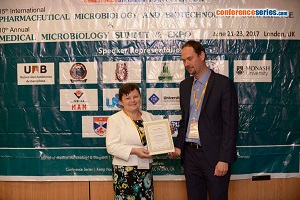
Urszula Kosikowska
Medical University of Lublin, Poland
Title: Activity of novel N-substituted-pyrazoles, dichlorobenzoylthiosemicarbazides, 2,4-thiazolidindiones and 1,2,4-triazole-ciprofloxacin hybrids on Haemophilus parainfluenzae and Haemophilus influenzae planktonic and biofilm-forming cells
Biography
Biography: Urszula Kosikowska
Abstract
Biofilm is a single- or multi-species highly specialized and multi-functional population of microorganisms living on natural or synthetic surfaces with specific biological and physicochemical properties. Biofilm is also an important factor in the pathogenesis of e.g. opportunistic infections. Among the important features of the biofilm cells is their resistance to drugs and other antimicrobial agents and host defense factors. Consequently, this may lead to therapeutic failures. Hemophilia, mainly Haemophilus parainfluenzae and nontypeable Haemophilus influenzae (NTHi), are opportunistic representatives of the respiratory microbiota which are able to live as biofilm and to cause recurrent or chronic and systemic infections (e.g. endocarditis, bronchitis and bacteremia or meningitis). On the basis of minimal inhibitory (MIC) and minimal biofilm inhibitory (MBIC) concentration values the differences in the effect of newly synthesized compounds on planktonic and biofilm-forming cells of hemophilia was observed. Among all the tested derivatives the highest activity against both planktonic and biofilm-forming cells of H. parainfluenzae was estimated for 1,2,4-triazole-ciprofloxacin hybrids and for N-ethyl-3-amino-5-oxo-4-phenyl-2,5-dihydro-1H-pyrazole-1-carbothioamide against both planktonic and biofilm-forming cells of H. parainfluenzae (including ampicillin-resistant strains) and H. influenzae. The basis for the activity of these compounds was the inhibition of enzymes important for DNA synthesis and cells’ metabolism as well as anti-adhesive properties in the early stages of biofilm formation. Other compounds, e.g. thiosemicarbazides and thiazolidinediones did not have a substantial inhibitory effect on both planktonic and biofilm-forming cells. The effect of the tested derivatives partially depends on species or strain of bacteria, compound’s structure and concentration, and time of incubation.





